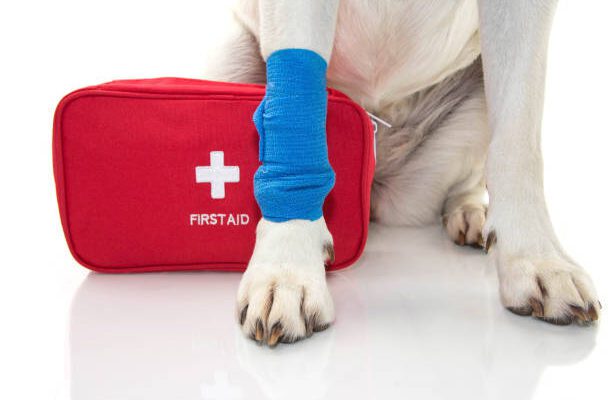We adore our pets. The safest, healthy, and happy life possible is what we desire to offer them. Pet parents must be prepared to give simple first aid to their dogs and cats in order to control them until they can receive medical attention from a veterinarian. The last thing you should be doing when a pet emergency arises is looking for supplies. Putting together pet’s first aid kit can ensure that you are ready for any situation.
Every six months or so, make sure to check your dog’s or cat’s first aid kit to see if any replacements or upgrades are required. Pet owners also need to know how to take care of their pets in an emergency. If a pet parent reacts quickly to a health issue with his or her dog or cat, it may make a significant difference in the outcome.
 (Photo from istock)
(Photo from istock)
Here are 10 things that you should keep on ready in your pet’s first aid kit:
-
Scissors with a blunt tip in pet’s first aid kit
It’s easy to forget a pair of scissors in a first aid kit for pets, but without them, treatment is frequently challenging. Scissors are used for a variety of tasks, including applying bandages and shaving the area around an injury.
Try to find scissors with blunt tips. Avoid cutting too near to the skin if you don’t want to unintentionally nick your pet. When shaving hair close to the eyes, nose, or ears, this is especially crucial.
-
Antibacterial Eye Solution
It’s distressing to consider that chemicals or other substances could get close to your pet’s eyes. The animal is prone to itch or massage the irritation further if it gets into the eye. Before attempting any treatment at home for eye injuries, speak with your veterinarian because they might be true emergencies.
If you are instructed to rinse your pet’s eye, you should have a good rinse ready. While there are several general eyewashes on the market, only a few have been created to specifically meet the requirements of dogs and cats.
-
Bandages in pet’s first aid kit
Any dog or cat first aid kit must have bandages. The bandage you use after an injury will frequently be temporary until you can reach your veterinarian. However, by offering support and limiting infection, it still plays a crucial function. In order to prevent bandages from coming off, they should be tight yet not so tight as to restrict blood flow.
By selecting a self-adhering bandage, you can simplify bandaging. This bandage is comprised of a material that applies pressure while decreasing the likelihood of cutting off circulation and won’t stick to skin or fur.
-
Latex or Rubber Gloves
Gloves are a need while providing first aid to animals. Wearing gloves reduces your chance of infection as well as the risk to your pet. Unintentionally contaminating an animal’s wound is surprisingly simple.
Think about storing several pairs of gloves in your kit. One pair might fall apart, or you might want assistance from a friend.
-
Medications in pet’s first aid kit
You might need to include specific prescriptions (including prescription meds) in your first aid kit for dogs depending on the needs of your particular dog or cat, but be sure to keep an eye on those expiration dates. Stocking your box with a few common cures is also useful in addition to any prescription meds.
Styptic powder is used to halt minor bleeding, especially if the quick of the nail has been cut too close to the nail or fractured. Hydrogen peroxide is a traditional component of first aid kits. It can be used to cause vomiting with the approval of your veterinarian or a poison control specialist.
-
Plastic Syringe
Anyone who has attempted to provide liquid-based oral pet meds to a restless pet will find a syringe to be helpful. Another purpose for a needleless syringe is to wash and disinfect a wound or to administer oral fluids to a pet that is dehydrated.
Keep your syringe clean and firmly closed until you need it. Simple feeder syringes come with two different tips, allowing for flexibility in application. If you need to provide a thicker amount of medication to your pet, pick a curved tip.
-
Tweezers in pet’s first aid kit
It can be challenging, if not impossible, to remove a sharp object from a pet’s skin with just your fingertips when it is a thorn or a piece of glass. The simpler, safer, and more hygienic option is to use tweezers.
Tweezers may also be required for tick removal. Tweezers make it much easier to remove ticks by allowing you to grasp them as close to your pet’s skin as possible.
-
Digital Thermometer
 (Photo from istock)
(Photo from istock)
You can estimate how serious your pet’s condition is by taking their temperature. It will also be useful information to share while speaking with your veterinarian on the phone.
Apply a lubricant with a petroleum or water basis on the thermometer’s end for stress-free insertion. If at all possible, have a companion divert and gently control the pet while you lift the tail just enough to insert the metal tip of the thermometer into your pet’s rectum (approximately one-half inch). Make sure the thermometer you choose has a minimum reading of 105 degrees Fahrenheit.
-
Antiseptic Wipes
Antiseptic Wipes the risk of infection is reduced by using antiseptic wipes or rinses to your pet’s wound. Cleaning the area around the face or in between the toes is particularly convenient when using wipes.
If you’re putting together a first aid pack for both dogs and cats. They are risk-free for both species and have no stings.
-
Emergency Phone Number Card
Make a note of the phone numbers for your veterinarian, a hospital that is open around-the-clock for emergencies, and animal poison control on a contact card. You can leave a copy of the card with the pet sitter if you have to leave your pet in their care. A copy should also be kept in your wallet.
Hence, these are a few items that you should include in your pet’s first aid kit.
References:
Looking for Fun games for your dog, click on the link below:
https://theperfectblogger.com/10-fun-games-to-play-with-your-pet-dog-in-summers/





2 Comments on “Things you need in Pet’s First Aid Kit”